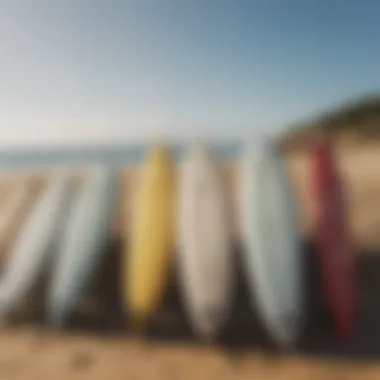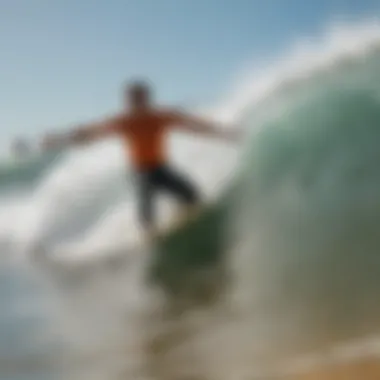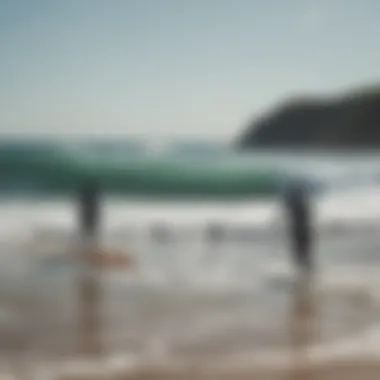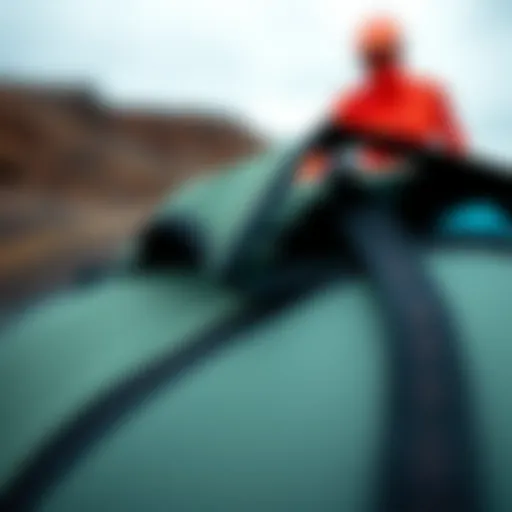Surfing in Lisbon: A Beginner's Essential Guide


Intro
Lisbon, a city embraced by the Atlantic Ocean, offers not just picturesque views, rich history, and vibrant culture, but also an inviting playground for those wanting to dive into surfing. For beginners, the thought of riding the waves can be both thrilling and intimidating. But fear not! This guide is crafted specifically for new surfers hoping to catch their first wave in this beautiful coastal destination.
In this guide, we’ll explore the essentials every budding surfer should know. From the best surf spots around Lisbon, tailor-made for novices, to the gear you’ll need to make your first surfing attempts smoother. We’ll navigate through fundamental techniques and skills to get you started on the right foot. Additionally, understanding surf culture is crucial in Lisbon, where a warm community welcomes newcomers with open arms.
By the time you finish reading, you'll be armed with the confidence and knowledge to help you take the plunge into the waves.
Surf Gear and Equipment
Getting the right surf gear is paramount for beginners. You want equipment that matches your skill level while ensuring safety and comfort. Whether you're planning to rent gear or purchase it, knowing what you'll need is essential.
Latest Surfboard Technologies
The kind of surfboard you choose can impact your learning curve. As a beginner, opting for a soft-top surfboard is often recommended. These boards are more forgiving in the water and reduce the risk of injury when you wipe out.
Modern surfboards come with various materials and designs that enhance performance. For instance, a funboard or longboard is ideal for beginners – they offer stability and easier paddling, making it simpler to catch those first waves. Keep an eye out for boards with a wider nose and more volume as they provide greater buoyancy.
Essential Accessories for Surfers
Besides the board, several accessories can enhance your experience:
- Leash: This is a rubber cord that attaches your board to your ankle, preventing it from floating away after a wipeout.
- Wetsuit: Essential for those cooler days, a wetsuit keeps you warm and can also provide some padding on impacts.
- Wax: This is applied to surfboards to provide grip, ensuring you don’t slip off during rides.
- Sunscreen: You will be spending time under the sun, so protect your skin with high SPF sunscreen, preferably one that is reef-safe.
Techniques and Skills
Once you’ve got your gear ready, it's time to focus on the skills that will help you master the waves.
Wave Riding Strategies
When it comes to catching waves, timing is everything. Start by watching where waves break before paddling out. Look for softer waves which are easier to ride.
To stand up, you should practice the pop-up maneuver on the beach before attempting it in the water. It involves transitioning from lying on your stomach to a standing position in one swift motion. Remember to keep your knees bent and look forward!
Safety and Surf Etiquette
Safety cannot be stressed enough. Always surf within your skill level and take notice of local surf conditions. Understanding rip currents and knowing how to handle them is crucial.
Surfers follow a few unwritten rules called etiquette:
- Priority: The surfer closest to the breaking wave has the right of way.
- Don’t Drop In: This means don’t paddle into waves that someone else is already riding.
- Respect other surfers: Maintain a friendly atmosphere and follow local customs.
With the right gear and understanding the basics, you can confidently start your surfing adventure in Lisbon. Remember, every expert surfer was once a beginner, so take your time and enjoy the ride!
Surfing as an Preamble to Lisbon
Surfing is more than just a sport; it’s a lifestyle that marries adventure with the beauty of nature. For many, learning to surf is a rite of passage, a bold step into an exhilarating world where the ocean becomes your playground. In Lisbon, this experience is magnified by the unique coastal culture and stunning beaches that line its shores. Not only is the city a hub for seasoned surfers, but it also serves as an inviting gateway for beginners looking to ride their first wave.
Overview of Lisbon's Surfing Scene
Lisbon boasts a diverse surfing scene that attracts both local enthusiasts and international travelers. The city's proximity to the Atlantic Ocean plays a pivotal role in its surfing reputation. With a variety of surf spots catering to different skill levels, aspiring surfers can choose beaches that best fit their needs. Locations like Costa da Caparica and Praia do Guincho are prime examples, offering consistent waves and beautiful settings.
Local surf schools dot the coastline, providing lessons tailored for newcomers. These schools emphasize safety and skill development while ensuring that the thrill of surfing is never lost. Friendly instructors and a vibrant surf community make it easy for beginners to integrate and find their feet in this dynamic sport.
Surfers in Lisbon often share tales of lively beach days, impromptu barbecues, and a strong sense of camaraderie. It’s not just about catching waves, but forming connections with people who share the same passion.
Why Lisbon is Ideal for Beginners
Lisbon is like a surfer's dreamland, especially for those just dipping their toes into the oceanic waters. Here’s why:


- Gentle Waves: Many beaches have mellow waves, which are perfect for learners. They help in building confidence without overwhelming beginners.
- Warm Climate: The temperate climate means novices can enjoy the water almost year-round, which is a significant perk for those wanting to practice regularly.
- Rich Culture: The city's blend of culture and surfing goes hand in hand. Beginners not only learn to surf but also get immersed in the local lifestyle, which adds to the overall experience.
- Accessibility: Being a city with good transport links, getting from the heart of Lisbon to the best surf spots is quick and easy. What’s more, many surf schools are within walking distance from public transport hubs.
In summary, once you hit the waters of Lisbon, you’re not just learning to surf; you’re stepping into a world full of excitement, peace, and connection with nature. It’s an adventure that’s waiting to unfold, with every wave telling a story.
"Surfing is like riding a wave of freedom. You’re not just learning to balance on a board; you’re discovering a piece of yourself in the embrace of the ocean."
Essential Gear for New Surfers
Getting the right gear is an important step for anyone starting to surf, especially first-timers. The essentials provide not just safety and comfort, but also enhance the overall experience on the waves. Knowing about surfboards, wetsuits, and other accessories can lay a strong foundation for surfing confidence and enjoyment.
Choosing the Right Surfboard
When it comes to selecting a surfboard, understanding the different types available is crucial. Every beginner has their style, and the surfboard plays a vital role in facilitating that journey.
Different Types of Surfboards
There are a few styles that are particularly popular among beginners. The longboard is usually favored for its stability and easier paddling. It's like the “big brother” of surfboards, giving new surfers more surface area to catch waves. On the other hand, shortboards are for those eager to progress quickly. Of course, they come with challenges; they are less stable and harder to balance on.
Unique to the longboard is its flat shape, which gives it excellent buoyancy. This design makes it perfect for riding smaller waves. The downside? Longboards can be cumbersome to carry. Shortboards, while slick and maneuverable in the water, may discourage newcomers because they require precise balance and a bit of skill.
Size Considerations for Beginners
Understanding surfboard size is also a big deal. Generally, larger boards offer more flotation and stability. Newbies often find it easier to learn how to stand up on a larger board, making them a popular choice.
However, smaller boards can help surfers progress faster; they assist in developing skills like turning and trick riding. Newcomers should be cautious, though. A board that is too small may lead to frequent wipeouts, which can be discouraging. Finding a balance based on weight and height is key here, and it’s often best to test a few options before settling on one.
Wetsuits and Accessories
Once you have the right surfboard, the next focus often turns to wetsuits and other accessories. They offer crucial protection against cool water, waves, and sun.
Wetsuit Thickness
The thickness of a wetsuit can greatly affect performance in the water. Generally, thicker suits are better for colder weather, while thinner ones are suited for warm summer days. A typical choice for Lisbon surfers might be a 3/2mm wetsuit, which provides a compromise on warmth and flexibility, allowing for both comfort and ease of motion.
The downside of thicker suits is that they may feel restrictive; this can put a damper on mobility for new surfers. Selecting the right thickness depending on the season can make a significant difference in comfort levels.
Additional Surf Accessories
Besides boards and wetsuits, thinking about accessories is crucial. Items such as surf leashes, padded board bags, and wax can greatly enhance the surfing experience. For instance, a leash ensures your board stays with you during wipeouts — a must-have for beginners who might be more prone to slips and falls.
Waxes are often not highlighted enough but can drastically improve grip on your board. It’s all about making sure you don’t go sliding off into oblivion as you’re transitioning from paddling to standing up.
"The right gear makes everything easier, especially when you’re just starting your surf journey."
Best Beginners' Surf Spots in Lisbon
Understanding where to surf as a novice can make all the difference in building confidence and skills. Lisbon boasts a variety of beaches that cater to learners, each featuring unique conditions and advantages. Knowing the right spots will not only ease the learning curve but also ensure a safer, more enjoyable surfing experience. These surf locations provide friendly waves and local support, crucial for those just starting out.
Praia do Guincho
Praia do Guincho is famed for its stunning natural beauty and consistent waves, making it a popular choice among beginners yet with a flair that appeals to experienced surfers as well. The beach is positioned near Cascais, offering a dramatic landscape with mountains on one side and the Atlantic Ocean on the other.
The waves here can be inviting, particularly when the conditions are optimal—sized right for beginners but not overly challenging. Surf schools frequently hold classes at Guincho, so it's easy to find guided lessons. The nice sandy bottom and constant swells help surfers learn balance and paddling effectively.
However, it is worth noting that on some windy days, the conditions can take a turn for the tricky. Hence, keeping an eye on the weather forecast—specifically wind and changing tide—is essential.
"Surfing is about feeling the ocean, like dancing with nature—start gently!"
Costa da Caparica
Just a short ride from central Lisbon, Costa da Caparica offers a long stretch of sandy beaches ideal for novice surfers. The waves here are generally mellow, making them perfect for learning the ropes. Plus, the wide beach means there’s plenty of room to spread out, allowing surfers to practice without crowding each other.


Local surf schools thrive here, and many offer rental equipment, which makes it convenient for beginners. One can often find experienced instructors who are not only skilled in surfing but also gracious in teaching. Furthermore, this beach tends to provide reliable surf conditions all year round, which encourages frequent practice—key for any new surfer.
Praia de Carcavelos
Praia de Carcavelos arguably ranks as one of the most accessible surf spots from Lisbon's city center. Just a 20-minute train ride away, it’s favored by many locals and tourists for its vibrant atmosphere. The venue offers a mixed bag of waves but is predominantly suitable for beginners, especially when the surf is on the smaller side.
The expansive beach setting means there are multiple peaks to choose from, allowing surfers to find a spot that matches their skill level. The presence of various surf schools along the shore makes it easy to dive into lessons or simply rent the necessary gear. The camaraderie among surfers is palpable, which often translates to a supportive learning environment.
Additionally, Carcavelos is known for its amenities. After a session in the water, surfers can recharge at nearby cafes and bars, all while soaking in the sunny ambiance.
In summation, selecting the right location to surf as a beginner can lead to an enriching experience filled with growth and enjoyment. Each of these spots brings something distinct to the table, whether it's the scenic beauty of Praia do Guincho, the thriving community at Costa da Caparica, or the accessibility of Praia de Carcavelos. With keen attention to environmental conditions and a willingness to learn, anyone can swiftly transition from novice to confident surfer.
Learning to Surf: Practical Tips
Surfing isn’t just about catching waves; it’s a dance with the ocean. For beginners, the journey can seem daunting, but practical tips can make the experience smoother. Understanding how to learn correctly from the start can build a solid foundation. This section serves as a guide to navigating early surfing stages, ensuring you feel comfortable as you plunge into this thrilling activity.
Taking Surf Lessons
Finding a Reputable Surf School
The first step in learning to surf is often enrolling in a surf school. Choosing the right surf school can radically impact your confidence and skills. A reputable surf school typically features certified instructors, who not only teach you how to ride waves but also impart essential safety information. They make the learning curve less steep by providing structured lessons tailored specifically for beginners.
Look for schools with good reviews and a friendly atmosphere. Avoid places that treat you as just another tourist with a wallet. For instance, local schools often have a community vibe, making it easier to ask questions. Each wave can present a different challenge, and personal guidance can ease the stress.
On the flip side, it’s worth acknowledging disadvantages. Some surf schools might focus too much on group lessons, giving less personalized attention. And not every school operates with ethical practices—be discerning to ensure you find one that prioritizes safety and enjoyment.
Lesson Structure and Expectations
Once you’ve selected a surf school, understanding the lesson structure is crucial. Most beginner lessons start on the beach, where instructors will break down the basics like paddling techniques and wave positioning. Finding a school that outlines their syllabus is a good sign; in a well-organized setup, you can expect a mix of theory and practical sessions.
Expectations can also set you up for success. Don’t anticipate to stand up on the first wave—it's more of a gradual process. Practicing how to fall safely is vital too, reinforcing that wiping out is part of growing as a surfer. Some schools have a potent mix of paddle practice intertwined with surf time, which helps in grasping the essentials quickly.
Once you enter the water, sticking with the group can create camaraderie, which can soothe nerves and build friendships. But do keep in mind; progress varies among individuals. The unique feature of this structure is that it highlights your individual growth through collaborative learning, balancing personal pace with group energy.
Understanding Wave Dynamics
Reading the Ocean
Diving into wave dynamics can feel like learning a new language. Reading the ocean means understanding what you see on the surface can be as crucial as the physical skills you develop. The ocean is a living entity, and its moods can affect your surfing experience drastically.
This skill involves taking stock of currents, identifying safe zones, and gauging wave size and intervals. A key characteristic of reading the ocean is that it elevates your safety— high rip currents can pose serious threats. By learning these elements early on, you enhance not just your performance, but your enjoyment too.
The charm of mastering this skill is that it helps you predict spots where your paddle strength matters more than you might think. Once you grasp this aspect, you'll find a deeper connection with surfing, moving beyond just the basics to truly engaging with the environment.
Timing Your Paddling
Timing is everything, especially when it comes to surfing. Knowing when to paddle can mean the difference between catching a wave and watching it pass you by. This aspect links closely with understanding wave dynamics; it’s not just about paddling hard but aligning your movements with the waves that break.
Instructors often emphasize the importance of paddling at the right moment. Ideally, you want to start paddling when the wave is far away and building up speed, allowing you to match the wave's energy as it approaches. When you get the timing right, the rush of catching a wave becomes exhilarating. It’s a ticket to a beautiful moment where you’re gliding powerfully across the water.
However, the downside of poor timing can lead to plenty of wipeouts. Overly eager paddling can wear you out before you even reach the wave. Understanding this balance can elevate your surfing experience and help you develop a rhythm that translates into a smoother riding experience.
"Perfecting timing is like dancing with the ocean; at times, you must lead, and sometimes you follow, but it is always a partnership."
This blend of practical tips not only encourages safety and personal growth but also builds a clearer roadmap as you start navigating your surf journey.
Safety Considerations for New Surfers
When stepping into the swirling waters of Lisbon's surf scene, safety should be your north star. Even the most seasoned surfers respect the ocean's unpredictability. For beginners, understanding the potential hazards can make all the difference between a thrilling experience and a frightening one. This section serves as a vital compass, guiding newcomers to recognize and navigate the unique aspects of surfing safety.
Currents and Tides


Currents can be downright sneaky and, at times, dangerous. The Atlantic can surprise you, with rip currents lurking beneath the surface. These currents pull water from the shore, and understanding how they work is crucial. Always check the local surf report and heed any warnings. The tides also play a vital role. They change the surf conditions dramatically, affecting wave size and water levels.
It's wise to be aware of the tide schedule when planning your surf day. Beginners should aim for the time when the tide is rising or falling, as this can create more manageable surf. Getting familiar with typical patterns at spots like Praia do Guincho or Costa da Caparica can be incredibly beneficial. Here are a few things to keep in mind:
- Look for signs or warnings: If you're unsure, don't be afraid to ask surf instructors or lifeguards in the area. They often have vital information about current conditions.
- Observe the local surfers: Experienced surfers can provide insight into which areas to avoid if the currents are particularly fierce.
- Stay with a buddy: Surfing alone, especially at unfamiliar beaches, can be a recipe for trouble. Pairing up not only enhances safety but also makes for a more enjoyable experience.
Understanding Surf Etiquette
Surf etiquette may sound like a set of formal rules, but it’s really more about mutual respect in the water. Understanding these unwritten rules helps create a harmonious surfing environment."Paddling out cleanly and respecting the waves will garner respect back", many seasoned surfers would say. Here are some key pointers:
- Know who has the right of way: Always give priority to the surfer closest to the peak of the wave. This is a crucial part of surf etiquette that newcomers should embrace to avoid collisions and bad vibes.
- Communicate: A simple wave or shout can go a long way. If you're about to drop in on a wave, let others know your intentions. This can prevent confusion.
- Avoid overcrowding: If surf spots get too busy, it might be best to find a less crowded location. It’s not only safer but also allows for a more enjoyable surfing experience.
Here's a quick recap:
- Respect the right of way.
- Communicate with other surfers.
- Seek out less crowded spots if necessary.
By keeping these considerations in mind, new surfers will not only ensure their own safety but also contribute to a positive surfing culture on Lisbon's picturesque beaches.
The Surf Culture in Lisbon
Lisbon's surf culture is not just a sporting activity; it is a way of life deeply rooted in the local community, spiced with passion, camaraderie, and respect for the ocean. When one thinks of surfing in Lisbon, the picturesque coastal views come to mind, but the real heart of surfing lies in the interactions and relationships among surfers that contribute to a vibrant lifestyle. This section delves into the elements that make Lisbon’s surf culture relatable and enriching for both novices and experienced surfers alike.
Local Surf Community
The local surf community in Lisbon is both welcoming and diverse. Surfers of all skill levels, from wide-eyed beginners to seasoned pros, come together to share their love for the waves. It’s common to see a mix of locals, international surfers, and even travelers looking to catch their first wave. The atmosphere is often informal and friendly, which makes it easy for beginners to feel right at home.
Within this community, groups often organize beach clean-ups, showcasing a collective care for coastal ecosystems. Surfers here don’t just ride the waves; they also advocate for sustainable practices, ensuring that the beaches remain pristine for future generations.
Additionally, the presence of numerous surf schools creates a nurturing environment where knowledge is freely exchanged. Whether it’s understanding the nuances of wave formation or just figuring out the best sunscreen, more experienced surfers are typically more than happy to lend a helping hand or share a story. Surf shops like Surf at the Beach and Lisboa Surf School act as community hubs, where one can find information, gear, or simply engage in conversations about the latest swell forecast.
Popular Surf Events and Competitions
Lisbon hosts a variety of surf events throughout the year, accentuating its position on the international surf map. These gatherings pull in surfers from all over, turning the local beaches into arenas of excitement and competition. Events range from local contests for amateurs at Costa da Caparica to the more serious international competitions at Praia do Guincho, where the best surfers showcase their skills.
Key events often include:
- Caparica Surf Fest: This annual festival celebrates the local surf scene with competitions, live music, and art displays. It’s a fantastic opportunity for both the seasoned competitors and the spectating crowd to connect.
- World Surf League Events: Occasionally, Lisbon earns the privilege of hosting these high-stakes competitions, attracting elite surfers and avid fans alike. It’s a real treat to witness the prowess of the world's best while soaking up local vibes.
Surf events here are more than just competitions; they're festivals of togetherness, drawing in locals and travelers who unite under the banner of surfing.
The surf culture in Lisbon stands as an extraordinary blend of community spirit, environmental awareness, and exhilarating events. Whether it’s participated in a local surf contest or simply enjoying a leisurely day on the beach, Lisbon offers a rich cultural landscape that enhances the surfing experience. For beginners, this supportive environment can significantly elevate their learning curve while providing lifelong memories in the surf-washed realm of Lisbon.
Post-Surfing: Recovery and Fitness
Surfing is not just a thrilling experience; it's also a physically demanding activity that can leave one feeling exhausted. Engaging with the ocean's waves requires strength, balance, and endurance. Hence, post-surfing recovery and fitness becomes paramount, especially for beginners who might not yet be accustomed to the rigors of the sport. Taking care of your body after a surf session amplifies performance and plays a critical role in avoiding injuries. Here, we’ll dive into effective stretching routines and nutrition strategies to help maximize recovery and sustain energy levels.
Stretching and Recovery Routines
Stretching well after surfing is like giving your body a nice hug after an arduous workout. It’s a way to reconnect with those muscles that worked double-time while riding waves.
- Benefits of Stretching:
Stretching post-surf can prevent stiffness, improve flexibility, and ultimately enhance performance. It can also help release any tension built up during your time in the water. - Routine to Follow:
Here’s a quick routine you can integrate after a surf session:
- Neck Rolls: Loosen the neck by gently rolling it side to side for about 30 seconds each.
- Shoulder Stretches: Cross your arm over your body, gently pulling it with the opposite hand for 15-30 seconds.
- Back Twists: Sit on the sand, legs crossed, and twist your torso side to side to release lower back tension—hold each side for about 15 seconds.
- Hip Openers: Stand up; put one foot on a bench or board, and lean forward to stretch the hip.
- Calf Stretches: Lean against a wall, place one foot back, and push the heel down while keeping the other leg bent.
These stretches should take about ten to fifteen minutes. It’s peaceful to stay on the beach while doing this, breathing in the salty air.
Nutrition for Surfers
Feeding your body the right fuel post-surf is just as important as paddling out. Proper nutrition will assist in muscle recovery and replenish the energy you've expended.
- Hydration:
First and foremost, drink water or an electrolyte drink immediately after your session to rehydrate. The ocean can take away more than just your energy. - Post-Surf Meal:
Focus on a balanced meal that includes proteins, fats, and carbohydrates. Consider the following examples: - Timing:
Ideally, eat within 30-60 minutes after surfing. This will help your muscles recover faster and replace the energy stores you’ve depleted.
- Banana and Peanut Butter: Quick energy with protein.
- Grilled Chicken Salad: Packed with protein and vitamins.
- Oatmeal with Berries: Provides both quick energy and fibers.
In summary, don’t underestimate the importance of recovery and nutrition in your surfing journey. Your body is your vehicle through the waves, and taking the right steps will lead to a more enjoyable and successful surf experience.
Remember, each surf session counts, and so does every minute your spend caring for your body.















